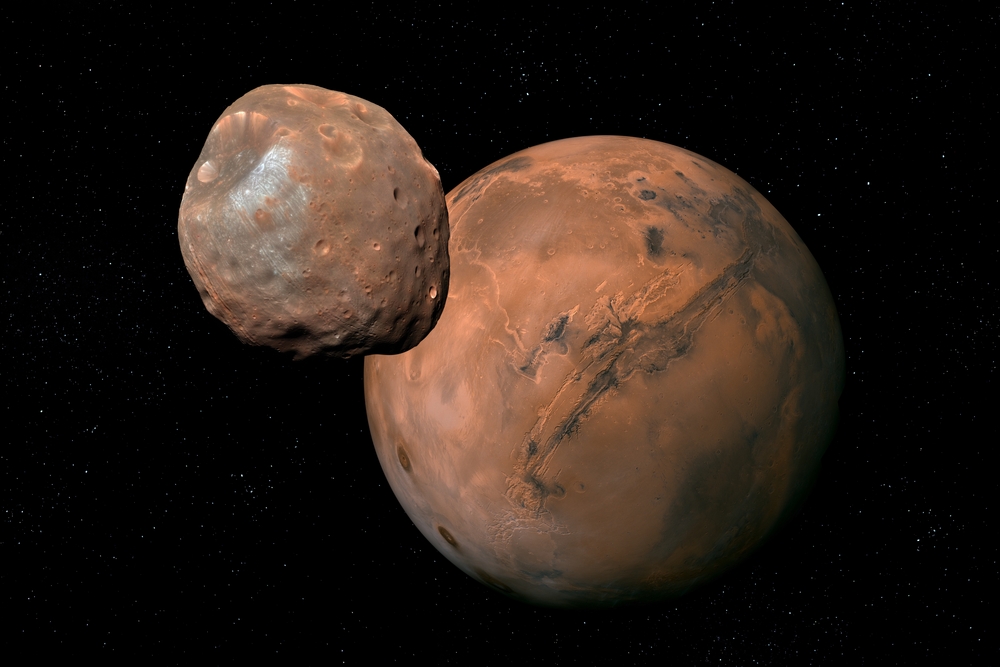Mars Moons Could Once Have Been Comets, Says Astronomers
Posted on Categories Discover Magazine

Phobos and Deimos are potato-shaped, heavily pock-marked rocks that are gravitationally bound to Mars. They are also two of the strangest moons in the Solar System.
For a start, they are tiny compared to their host—Phobos is just 20 kilometers across. They are much less dense than Mars and heavily cratered, suggesting a colorful past. They also have some peculiar features, such as the grooves on the surface of Phobos that stretch for over a kilometer.
The puzzle for astronomers is to determine where these moons came from, particularly given that their two theories have serious shortcomings.
Captured!
Now astronomers studying images of the moons captured by the Mars Express spacecraft have come up with another theory. Phobos and Deimos, they say, were originally a binary comet that separated into two moons after it was captured by Mars’ gravitational field.
First some background. Astronomers have two competing theories to explain the origin of the Martian moons. The first is that Phobos and Deimos are asteroids captured by Mars’ gravitational field. The moons look similar to so-called D-type asteroids found in the outer asteroid belt and among Jupiter’s Trojan asteroids. These asteroids are known to be rich in organic materials, silicates and possibly water ice, all of which would be hugely valuable to future Mars explorers.
The problem is that the moons’ orbits are not consistent with this origin. When astronomers simulate this kind of capture, the moons never end up in the orbits that Deimos and Phobos have today, which are both approximately equatorial.
The second theory is that early in the Solar System’s history, Mars was involved in a collision that produced a disc of debris around the planet’s equator. Phobos and Deimos formed from this disc, in exactly the orbits they have today.
But this theory doesn’t explain why Phobos and Deimos look so similar to D-type asteroids with their carbonaceous surfaces.
Enter Sonia Fornasier at the Université Paris Cité in France and colleagues who say that another theory more clearly fits the observations. In 2003, the European Space Agency placed the Mars Express spacecraft in orbit around the Red Planet, equipped with high-resolution cameras capable of resolving features on Phobos the size of small cars.
Since then, Mars Express has sent back the most detailed images of Phobos ever taken. That has allowed Fornasier and co to compare the surface of Phobos with other well studied objects throughout the Solar System, such as the dwarf planet Ceres, the asteroids Steins and Lutetia, the Kuiper Belt object Arrokorth, plus Comet 67P, a strange, twin-lobed body visited by ESA’s Rosetta and Philae spacecraft ten years ago.
The closest match comes as something of a surprise. “Overall, our photometric analysis has shown that Phobos photometric properties show a close resemblance to those of comet 67P,” say Fornasier and co.
Phobos Lander
That raises the curious possibility that the origin theories for the Mars moons are entirely wrong. “Phobos and Deimos may currently be exhausted cometary nuclei captured by Mars,” say the team. In fact, their similar orbits suggest they may have come from a single comet with two nuclei or a twin lobed comet like 67P that was slowly ripped apart by Mars’ gravitational field.
That’s a fascinating idea that will pique the interest of planetary geologists around the world. They may not have long to wait before Phobos origin is finally answered.
In 2026, the Japanese space agency JAXA will launch the Martian Moons eXploration mission or MMX. Its goal is to study the moons, to land on Phobos and ultimately, to bring samples back to Earth. That’s a high-risk mission with huge potential rewards. Not least of these is that it could finally solve the conundrum of where Phobos and Demos came from. Fornasier and co must be holding their collective breath!
Ref: Phobos photometric properties from Mars Express HRSC observations: arxiv.org/abs/2403.12156